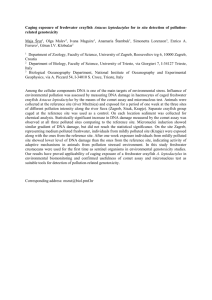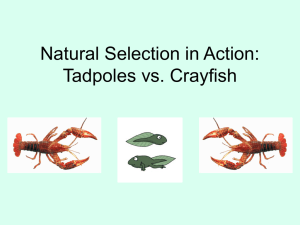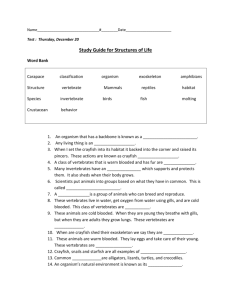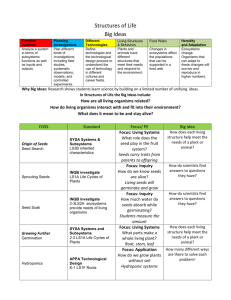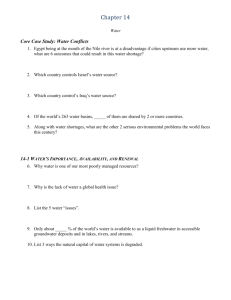Freshwater Crayfish - Department of Fisheries
advertisement
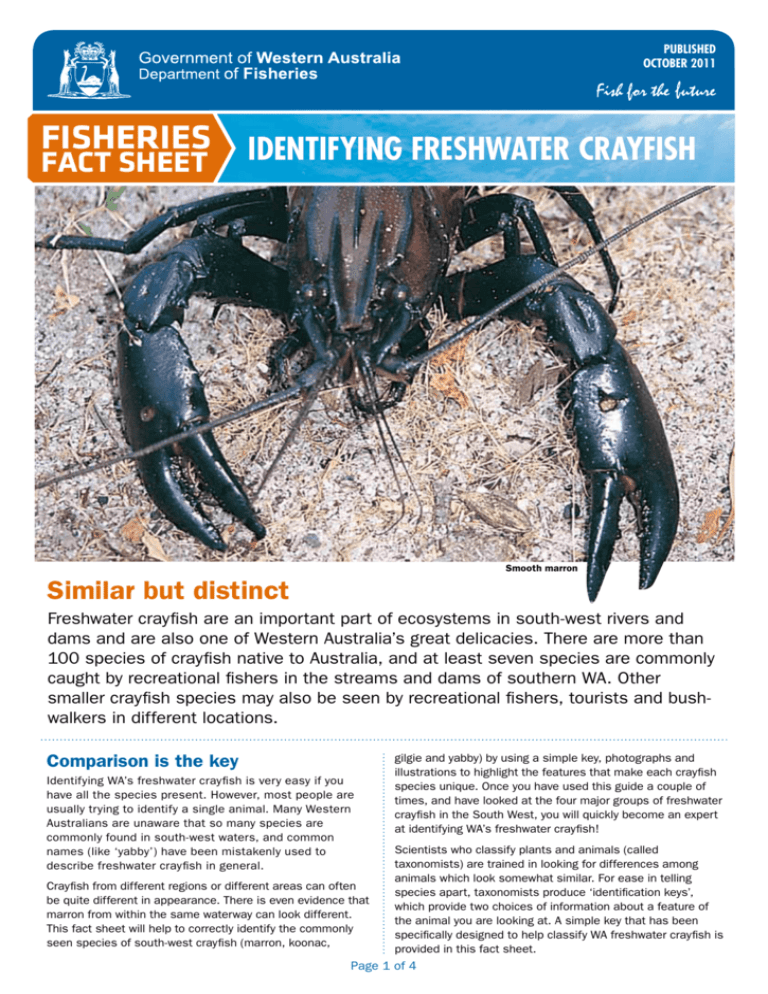
PUBLISHED OCTOBER 2011 FISHERIES Identifying Freshwater Crayfish FACT SHEET Smooth marron Similar but distinct Freshwater crayfish are an important part of ecosystems in south-west rivers and dams and are also one of Western Australia’s great delicacies. There are more than 100 species of crayfish native to Australia, and at least seven species are commonly caught by recreational fishers in the streams and dams of southern WA. Other smaller crayfish species may also be seen by recreational fishers, tourists and bushwalkers in different locations. Comparison is the key Identifying WA’s freshwater crayfish is very easy if you have all the species present. However, most people are usually trying to identify a single animal. Many Western Australians are unaware that so many species are commonly found in south-west waters, and common names (like ‘yabby’) have been mistakenly used to describe freshwater crayfish in general. Crayfish from different regions or different areas can often be quite different in appearance. There is even evidence that marron from within the same waterway can look different. This fact sheet will help to correctly identify the commonly seen species of south-west crayfish (marron, koonac, gilgie and yabby) by using a simple key, photographs and illustrations to highlight the features that make each crayfish species unique. Once you have used this guide a couple of times, and have looked at the four major groups of freshwater crayfish in the South West, you will quickly become an expert at identifying WA’s freshwater crayfish! Scientists who classify plants and animals (called taxonomists) are trained in looking for differences among animals which look somewhat similar. For ease in telling species apart, taxonomists produce ‘identification keys’, which provide two choices of information about a feature of the animal you are looking at. A simple key that has been specifically designed to help classify WA freshwater crayfish is provided in this fact sheet. Page 1 of 4 Features of freshwater crayfish Carapace: Protective shell covering the crayfish head and abdomen. Measuring zone Cervical groove: Semicircular notch that divides the head of the crayfish. Telson spine Chelipeds: The claws of freshwater crayfish. Keel: A long ridge that runs lengthwise along the top of the head. Rostrum: The long spike that sticks forward from the head between the eyes. Carapace Keel Measuring zone: Measure from the tip of the rostrum to the back of the carapace. Uropods Rostrum Chelipeds Telson: The middle ‘panel’ of the tail. Cervical groove Telson spine: Tail spine found only on marron. Telson Uropods: The two pairs of ‘fans’ on either side of the telson that make up the tail. Elbow (This is a smooth marron) Illustration © R.Swainston/www.anima.net.au Key to identifying freshwater crayfish The key is very simple to use. Simply start at point 1 and read the two choices you have. Decide which of the choices fits the crayfish best and look below the description. If it provides a number, then go to that numbered point and again read the choices. Alternatively, if a name is provided, then you have matched your crayfish to the likely species. START 1 select For example, a crayfish has four keels on the head and no spines on the rostrum. Starting at section 1, this description fits best with point 1b. After point 1b it says, “Go to 3”. At section 3, the best fit is 3b, that the claws are elongated and quite large and there are hairs inside the ‘elbow’. Therefore, you have successfully identified a yabby. 1a Five obvious keels on the head. Small spines present on the rostrum. 2 Go to 2 select 1b Four keels on the head but usually only two keels are obvious. No spines present on the rostrum at all. Go to 3 2a Two small spines on the telson, located about halfway up. Three pairs of small spines on the rostrum. 2b No spines on the telson. Two pairs of small spines on the rostrum. Gilgie (2 species) Marron (2 types) Go to 4 3 select 3a Chelipeds (claws) are oval in shape and quite broad. Koonac (2 species) 4 3b Chelipeds (claws) elongated and quite large. Obvious hairs on the inside of the ‘elbow’. Yabby (2 species) select 4a Middle keel extends all the way to the cervical groove. Head covered with short hairs. 4b Middle keel does not extend to the cervical groove. No hairs on head. Margaret River Hairy Marron Smooth Marron Page 2 of 4 Marron Marron are the largest freshwater crayfish in the south-west of WA and one of the largest freshwater crayfish species on earth. Before the introduction of other freshwater fishes, marron were the largest animal in south-west rivers. Originally only found between Harvey and Albany, the range of marron has been extended by the ‘seeding’ of rivers and irrigation dams with juvenile marron, along with their use in aquaculture ventures. Marron are now found in rivers and dams from the Hutt River (north of Geraldton) to east of Esperance. There are small populations of marron in dams in the Goldfields. Marron prefer sandy areas in rivers and dams, particularly areas that have lots of structure (fallen trees, rocks) but do not tolerate high salinity. Marron can grow more than 380 mm (total length) and they are usually measured from the tip of the rostrum to the back of the carapace. Marron possess five keels along the head, three pairs of short spines on the rostrum, two small spines on the telson and narrow, pincer-like chelipeds (claws). They range in colour from jet-black to brown or even striped, red and cobalt-blue, a rare natural version now farmed for aquariums. Smooth marron photo and illustrations There are two types of marron found in WA – smooth and hairy. Smooth marron are widespread and found in most south-west rivers and dams. They are what most marroners have seen and captured, and are the farmed aquaculture species. Hairy marron are found almost exclusively in the upper reaches of Margaret River. The head and sometimes tail (of larger marron) are covered in clusters of short hairs. The central keel also extends all the way to the cervical groove. Hairy marron are threatened by smooth marron that have become established throughout Margaret River. The Department of Fisheries is restocking hairy marron to assist the recovery of this endangered type. The upper reaches of Margaret River are now closed to recreational fishing, so if you capture hairy marron in Margaret River, please put them back immediately. Recreational fishers in WA need a licence to catch marron. A detailed information brochure about marron fishing is available from the Department of Fisheries website at www.fish.wa.gov.au. Hairy marron photo and illustrations Gilgie (two species in WA) Gilgies can be commonly found in most streams, rivers and irrigation dams in the South West, and are often caught while fishers are marroning. Gilgies can burrow to escape drought and have a wider distribution than marron. Gilgies also have five keels along the head, like marron, but only have two pairs of small spines on the rostrum. Gilgies do not have any spines on the telson. Gilgie chelipeds are narrower than those of koonacs or yabbies. Most gilgies are small, but may reach 130 mm in total length. Gilgies range in colour from a black-brown to a light brown colour, and often have speckled patterns on their chelipeds (claws). Gilgie photo and illustrations Page 3 of 4 Koonac (two species in WA) Koonacs are also relatively large freshwater crayfish, growing up to 200 mm in total length. However, their distribution is further inland than that of marron, and they are often found in seasonal rivers and swamps that dry-up during summer. Koonacs survive drought because they can burrow and remain there for months at a time. Koonacs have four keels on the head and two are very prominent. Koonacs have no spines on the rostrum or telson. The chelipeds (claws) are unique, being very broad and serrated on the inside edge. Koonacs are usually very dark in colour, ranging from blueblack to mottled brown-black. Koonac photo and illustrations Yabby Yabbies are an introduced species to WA. They are native to New South Wales, Victoria and South Australia, and were stocked into farm dams in WA in 1932. Yabbies can now be found in some south-west rivers and dams. Yabbies are much smaller than marron – very few yabbies grow to 130 mm in length. Yabbies can range from a beige or coffee colour to almost black. They can also take on a blue colour when held in aquariums for a long time. Their head has four keels, with two keels being very obvious, and have a short rostrum with no spines. The inner edges of the chelipeds (claws) have a mat of very obvious hairs not found on other crayfish species in WA. Yabbies are a threat to the marron fishery, as they breed faster than marron and may carry diseases that affect other freshwater crayfish. Help preserve native species; never release yabbies into rivers, lakes and dams and do not use them as live bait. If you catch a yabby, keep it. Yabby photo and illustrations References Websites: Department of Fisheries, Western Australia www.fish.wa.gov.au Freshwater Fish Distribution in WA freshwater.fish.wa.gov.au FURTHER INFORMATION This fact sheet is the twenty third (No. 23) in a Department of Fisheries series. ISSN 1834-9382 DEPARTMENT OF FISHERIES – HEAD OFFICE 3rd Floor, The Atrium, 168 St George’s Terrace, Perth 6000 Ph (08) 9482 7333 Fax (08) 9482 7389 e-mail: headoffice@fish.wa.gov.au ABN: 55 689 794 771 Page 4 of 4 P&A132 OCT 2011 Visit the Department’s website at www.fish.wa.gov.au or contact:
